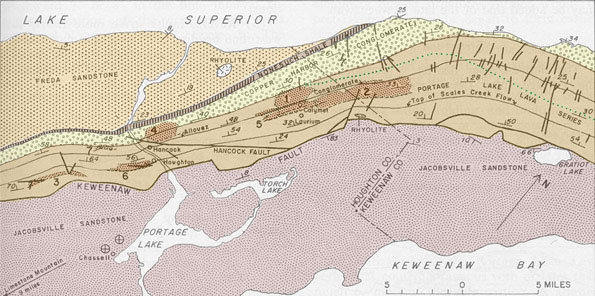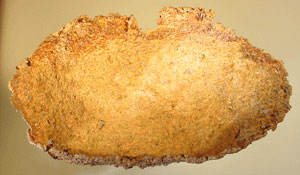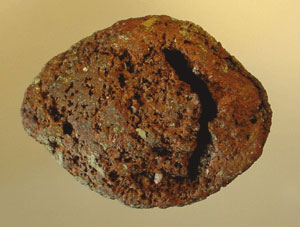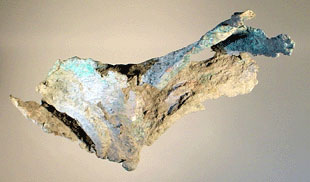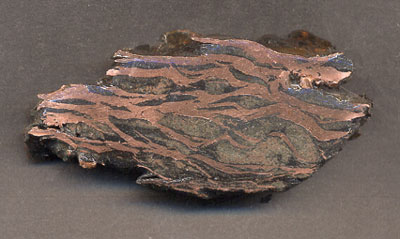| Home | AmMin | GMR | RiMG | Collectors Corner | Directory | Short Courses | |
|
|
|||||||

|
VIRTUAL FIELD TRIP TO THE KEWEENAW PENINSULA, MICHIGAN - ORE FORMATION
|
The formation of the native copper ores is not completely understood. The fact that it is a relatively unique deposit of a very large size makes the understanding of the ore formation processes problematic. The lack of sulfur in the ores is a very unusual feature in the formation of copper deposits. Most copper ore deposits will contain some native copper, but is usually just found in the oxidized zone (gossan) of the deposits. It is usually associated with cuprite, tenorite, and other secondary copper minerals such as azurite, malachite, chrysocolla, etcetera. Often they will be found as elongated spinel twins in gossans, but in the Lake Superior ores, this habit is rare. The two theories for the formation of the ore fluids is that they either were associated with the final stages of the magmatism, or were created by the burial metamorphism of the volcanic and sedimentary rocks. The ore formed approximately 30 million years after the deposition of the Portage Lake Volcanics. This date was obtained by radiometric dating (K-Ar) of adularia that is found associated with copper in the amygdaloids in the rocks. The more permeable sections of the flows and sedimentary rocks are highly altered. Most of the rocks were subjected to either zeolite grade metamorphism (<200°C) or prehnite-pumpellyite grade metamorphism (200-400°C). The low permeability interior of the flows still have the original igneous mineralogy. The economic copper deposits are usually found in association with quartz and epidote. The volcanic rocks had a relatively low sulfur content since they were extrusive and most of the sulfur in the magma could have been vented into the atmosphere. Subsequent leaching of copper ( probably contained in low concentrations in the iron/titanium oxides) would have resulted in a sulfur poor fluid. The copper was most likely carried as a chloride complex in a (5-10%) Ca-Na brine. The deposition of copper from these ore fluids was most likely caused by a combination of mixing of the copper-bearing fluids with meteoric water, reactions with the wall rock, and cooling of the solutions. There is a strong correlation with the structure of the peninsula in the localization of economic copper deposits. The best ore grades were usually associated with faults that provided pathways for fluids generated in the deeper rocks to escape, but limited the outward movement of the ore bearing fluids. The Allouez gap fault intersected the largest number of ore bearing rocks ( up to 60% of the district's production). |
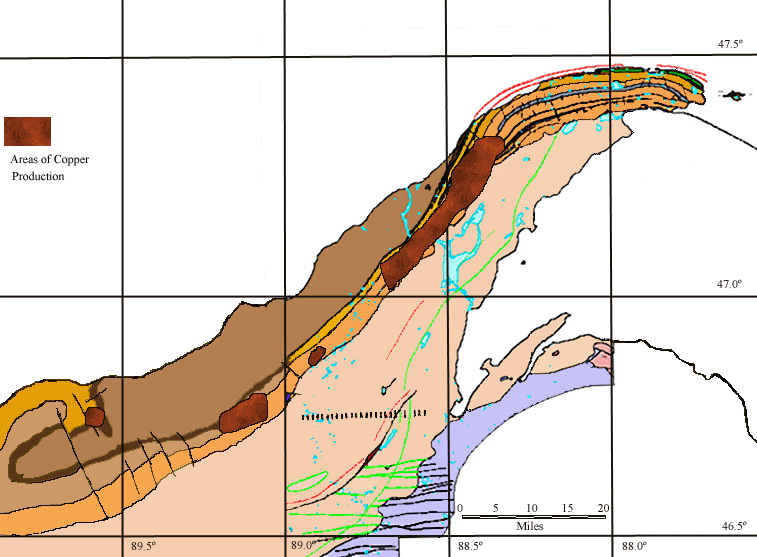
|
Going from the tip of the Keweenaw to the southwest are four areas of copper production. The main area of copper production is in the northeastern portion of the peninsula and runs from Mohawk to Painesville. A very minor occurrence is south of this area near Winona. Another area of copper production was between Mass City and Victoria. Another major producing area was to the west in the White Pine area.
Geologic map of the major copper producing area. Major deposits 1) Calumet & Hecla conglomerate; 2) Kearsarge amygdaloid; 3) Baltic amygdaloid; 4) Quincy mine; 5) Osceola amygdaloid; 6) Isle Royale mine; 7) Atlantic mine. Heavy dotted green line is northern limit of abundant quartz in amygdaloids. After W. White "The native-copper deposits of northern Michigan" in "Ore deposits of the United States, 1933-67" AIME.
This is a 12cm piece of native copper. It filled a narrow fracture in the rock. It was bent during the mining operations. From the Central mine dumps. The copper shows the blue/green oxidation to malachite or azurite. |
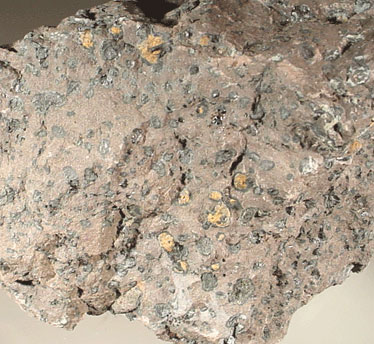 |
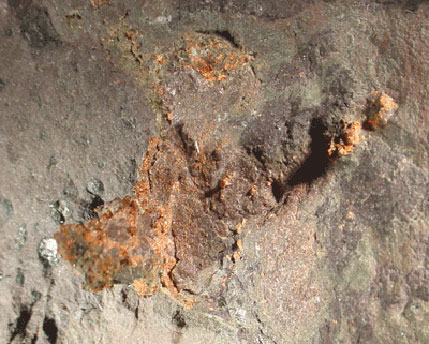 |
| This is an amygdaloidal ore. Note some of the vesicles have been filled with native copper. Other vesicles have been filled by dark green pumpellyite. Copper vesicles are 5 mm across. | Chunks of copper in an amygdaloidal rock. Larger vesicles to fractures are filled with native copper (vertical field of view 10 cm). |
Additional ore photographs
|
The White Pine deposit is similar to some of the Keweenaw deposits as some native copper ( the second phase of mineralization) was deposited at the same time as the major copper deposits to the north. It was one of the few mines to successfully exploit a sulfide ore. The Nonesuch shale contains copper sulfides over much of the area in which it was deposited, but there were only economic concentrations at the White Pine mine and in the Presque Isle syncline west of the Porcupine Mountains. The deposit was formed when pyrite near the base of the shale was replaced by chalcocite when copper bearing fluids circulated through the rocks in the closing stages of deposition of the Nonesuch shale (diagenesis - loss of water in the compaction of clays and sediments into rocks). The second stage of mineralization occurred when the mid-continent rift was being closed and fluids from the low grade metamorphism of the volcanic rocks circulated through the beds ( the same age as the deposition of the majority of the native copper in the rest of the Keweenaw). The fluids were introduced into the rocks through the thrust faults (White Pine Fault) This mineralization consisted primarily of native copper and silver with subordinate chalcocite. Domeykite was also found in veins in this assemblage. The copper sulfides are concentrated within the shale beds, while native copper is more common in the upper beds of the Copper Harbor Conglomerate.
Specimen of Nonesuch shale showing major replacement by native copper. The copper shows deformation of the sediment. Light greenish areas between native copper veins are primarily shale rock with minor replacement of very fine grained native copper. Specimen is 6 cm. across. |
